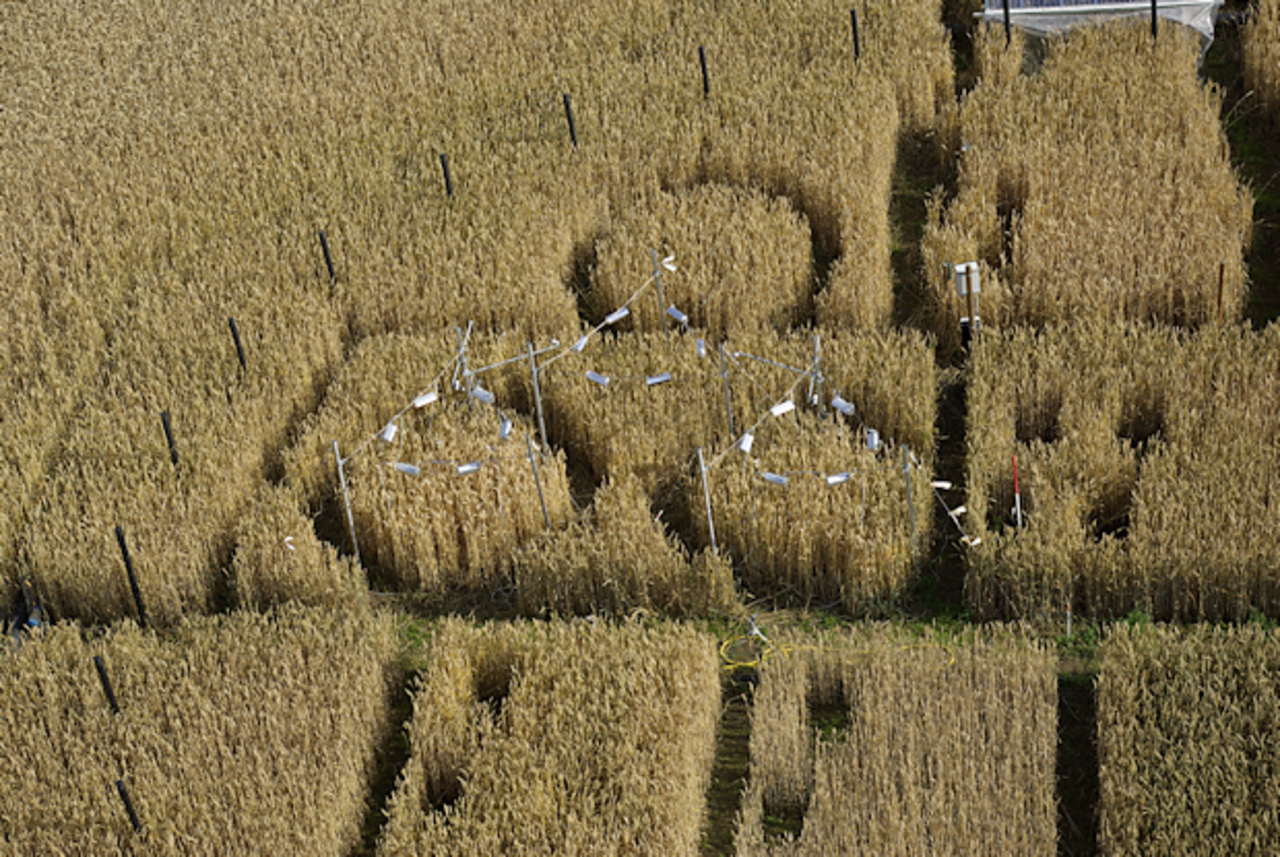Project
Risk to wheat yield by heat stress during anthesis

Field studies on the interaction of heat stress and elevated atmospheric CO2 concentrations on growth and grain development of wheat
Recent modeling studies addressing the effect of future climate change on wheat revealed that drought stress and especially heat stress will substantially impair the yield stability of wheat not only in Germany and Europe but also on a global level. The algorithm in the model for the assessment of the heat stress effect on total plant and especially on grain growth is based on previous experimental studies done in controlled environment chambers or in green houses. Field studies with simultaneo
Background and Objective
The objective is to improve the quantification of the effect of high temperature or heat stress on grain yield components. In addition, it will be investigated, whether increasing CO2 concentrations enhances or mitigates these effects of high temperature or heat stress on grain yield. Heat stress will be applied during anthesis, since wheat seems to be most sensible to heat during this period.
Target Group
Experimental results will be provided to the scientific community. In addition, data will be made available to different modelling teams for improving their models.
Approach
Field experiments will be carried out, in which wheat plants are exposed to elevated temperature and also to elevated CO2 concentration under sufficient water supply.
Data and Methods
Crop growth will be measured during the vegetation period. In addition surface temperature of the whole canopy and individual organs (leaf, ear) will be measured.
Our Research Questions
- What is the threshold value above which grain number is decreased by high temperature?
- Is grain number under heat stress a function of temperature sum above the threshold?
- Is individual grain weight decreased by heat stress or does it increase and thus mitigate the decline of grain number?
- Does the rise of CO2 concentration enhance or mitigate the effect of heat stress on wheat grain yield?
Results
- Field studies with winter wheat were done over three years and maximum temperature around anthesis ranged from 30-33°C.
- Through FATE technique temperature could be further increased by 3-6°
- Canopy of wheat was warmer under FACE than ambient CO2 also under FATE
- There were no significant heat effects on grain yield.
- In addition, wheat was grown in pots in the greenhouse and near anthesis plants were moved to a controlled environment chamber and exposed to high temperatures (32°C - 40°C). It was found that 50% loss of grain yield occured at heat thermal time of 30°C x d (T>30°C). This corresponds to a heat wave of e.g. 10 days with 36°C for 12h daily. Such an event is extremely unlikely for Germany under climate change in this century
Involved external Thünen-Partners
- Christian-Albrechts-Universität zu Kiel
(Kiel, Deutschland) -
Rheinische Friedrich-Wilhelms-Universität Bonn
(Bonn, Deutschland) -
Martin-Luther-Universität Halle-Wittenberg
(Halle (Saale), Deutschland) - Julius Kühn-Institut - Bundesforschungsinstitut für Kulturpflanzen (JKI)
(Quedlinburg, Braunschweig, Groß Lüsewitz, Kleinmachnow, Deutschland)
Funding Body
-
Deutsche Forschungsgemeinschaft (DFG)
(national, öffentlich)
Duration
4.2012 - 9.2018
More Information
Project funding number: MA 1736/3-1
Project status:
finished
Publications
- 0
Neukam D, Ahrends HE, Luig A, Manderscheid R, Kage H (2016) Integrating wheat canopy temperatures in crop system models. Agronomy 6(7):19 S., DOI:10.3390/agronomy6010007
- 1
Luig A, Manderscheid R, Erbs M, Ratjen A, Weigel H-J, Kage H (2016) Towards a simple model for winter wheat's grain filling dynamics considering heat effects. In: Ewert F, Boote KJ, Rötter RP, Thorburn PJ, Nendel C (eds) International Crop Modelling Symposium 15-17 march 2016, Berlin, book of abstracts. pp 308-309
- 2
Luig A, Manderscheid R, Erbs M, Ratjen A, Weigel H-J, Kage H (2016) Yield reaction of winter wheat to high atmospheric CO2 concentration and heat stress. In: FACEing the future : food production and ecosystems under a changing climate, 26. – 29. September 2016, Justus Liebig University Giessen, Germany, Book of Abstracts. p 51
- 3
Erbs M, Manderscheid R, Luig A, Kage H, Weigel H-J (2015) A field experiment to test interactive effects of elevated CO2 concentration (FACE) and elevated canopy temperature (FATE) on wheat. Proced Environ Sci 29:60-61, DOI:10.1016/j.proenv.2015.07.157
- 4
Luig A, Manderscheid R, Erbs M, Ratjen A, Weigel H-J, Kage H (2015) Wie beeinflussen erhöhte CO2-Konzentrationen (FACE) und temporär erhöhte Bestandestemperaturen (T-FACE) sowie deren Interaktion die Ertragsphysiologie von Winterweizen? - Ergebnisse eines Feldversuches. Mitt Gesellsch Pflanzenbauwiss 27:51-52
- 5
Manderscheid R, Erbs M, Weigel H-J (2013) Field studies on the interaction of drought or heat stress and elevated atmospheric CO2 concentrations on growth and yield of C4 and C3 crops. In: Abstracts / Climate extremes and biogeochemical cycles 2013 : 2 - 5 April 2013, Congress Center Seefeld / Austria. Seefeld, p 243
- 6
Manderscheid R, Ewert F, Kage H, Müller J, Siebert S, Weigel H-J (2012) Integrierte Multiskalenmodelle: ein neuer systemübergreifender Ansatz bei Kulturpflanzen zur Anwendung in der Biomasse- und Klimafolgenforschung auf der Grundlage innovativer Experimente. Mitt Gesellsch Pflanzenbauwiss 24:277-278

![[Translate to English:] [Translate to English:]](/media/_processed_/4/0/csm_Titel_Ant_Plot_1c3363e3f7.png)
![[Translate to English:] [Translate to English:]](/media/_processed_/b/3/csm_Titel_93px_Ant_Plot_0ef6a20d79.png)
![[Translate to English:] Logo des Bundesministerium für Ernährung und Landwirtschaft](/media/allgemein/logos/BMEL_Logo.svg)